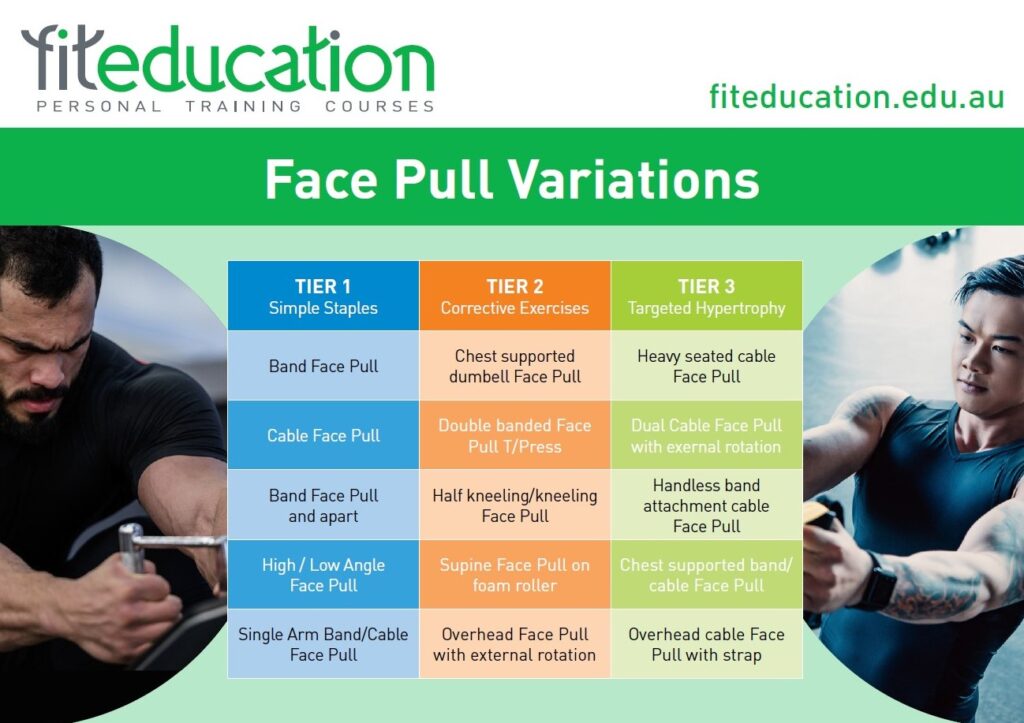Face Pull: The standing face pull is an isolation exercise primarily targeting the rear deltoids, traps, and upper back. It is most often performed with a rope attachment. Set up a band / cable machine with a double-rope attachment fixed to the high pulley. Grasp the handle in an overhand grip (palms facing the floor) and hold it with arms fully extended out in front of you. Pull the handles towards you, keeping your upper arms parallel to the floor, so that the handles go either side of your face. Then return to the starting position, keeping the tension in the cable. Keep the movements slow and controlled .
Step-by-Step Instructions
Set up a cable pulley machine so the pulley system is positioned slightly above your head. Use the rope attachment that features two hand-holds for this exercise.
- Reach up and grasp the handles with both hands with your palms facing in. Step back until your arms are fully extended, then engage your core and lean back slightly, positioning your body at a roughly 20-degree angle.
- Pull the rope toward you just enough to start lifting the weight from the stack, then engage your shoulders, rolling them back to create good posture—you don’t want your shoulders hunching or rolling forward. This is your starting position.
- Pull the handles of the attachment straight toward your forehead. Keep your palms facing in as your elbows flare outward toward the sides, engaging the rear delts.
- Reverse the movement and slowly extend your arms without allowing your shoulders or chest to roll forward as you extend—you want to maintain good posture throughout the exercise.

Common Mistakes
Poor Form
The most common culprit when it comes to doing face pulls incorrectly is simply not understanding what are the muscles that have to work. This is a rear delt exercise, so you should feel it working the back side of your shoulders into your upper back between your shoulder blades. If you start pulling the attachment toward your chin or neck, or your elbows start pointing down instead of out, and also if you fail to keep your palms facing in, chances are you’re going to feel it more in your biceps and back. Similarly, if you do, double check your form. If the arms are not at right angles to the body, you are performing a pull-down rather than a face pull.
Too Much Weight
It’s also pretty common to overload select too much weight. The rear delts are a smaller muscle group, and if you don’t usually work with them, you’re going to need to go lighter than you would with other shoulder exercises. If you find you’re using momentum to pull the attachment toward your body, or if you can’t control the weight as it returns to the stack, pulling your body forward, then you should probably reduce the amount of weight you’re trying to lift. To target the rear delts effectively, you need to make sure you’re not inadvertently recruiting additional muscle groups to take over to perform the exercise.

Check out these other resistance training exercises:
- Bench Press
- The Turkish Get Up
- Front Squat.
- Shoulder Press – Standing Barbell
- Single Leg Squat
- Lunge
- Battle rope
- Overhead Barbell Squat
- Deadbug – Abdominal Exercise
- Monster Walk
- Goblet Squat
Resistance training is covered in the Cert 3 in Fitness and Cert 4 in Fitness.
